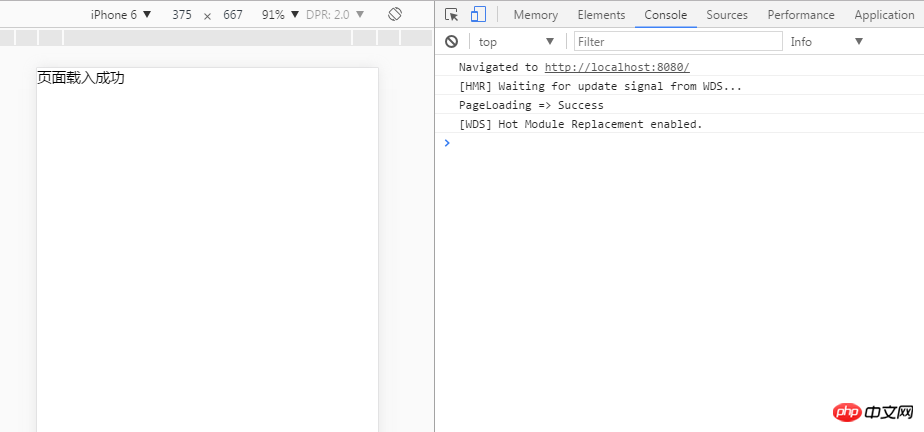这次给大家带来怎么使用webpack3.0配置webpack-dev-server,使用webpack3.0配置webpack-dev-server的注意事项有哪些,下面就是实战案例,一起来看一下。
最近正在研究webpack,听说webpack可以自己搭建一个小型的服务器(使用过vue-cli的朋友应该都见识到过),所以迫不及待的想要尝试一下。不过,在实际操作中发现,用webpack搭建服务器仍有不少坑,一方面是由于自己对文档的不熟悉,不了解webpack-dev-server的运作模式;另一方面,在翻阅了不少博客和文章后,发现不少配置实际上都跑不起来(有可能是版本的原因,也有可能是我自己配置的原因)。所以我打算用webpack3.0把dev-server跑起来给大家演示一遍,顺便把一些配置和原理给大家讲清楚,这样就省的绕弯路了。
这里我就默认大家都已经安装了webpack以及自己需要使用的loader和plugins,由于webpack-dev-server是个独立的npm包,所以我们需要在npm下安装它:
npm install webpack-dev-server --save-dev
之后我们就可以在webpack.config.js中进行配置:
const path = require("path");
module.exports = {
entyr:{
....... //设置入口文件
},
output:{
....... //设置出口文件
},
module:{
....... //配置loader,注意使用rules而不是loaders
},
plugins:[
....... //注意是数组
],
devServer:{
//我们在这里对webpack-dev-server进行配置
}
}devServer中常用的配置对象属性如下:
1. contentBase:"./" // 本地服务器在哪个目录搭建页面,一般我们在当前目录即可;
2. historyApiFallback:true // 当我们搭建spa应用时非常有用,它使用的是HTML5 History Api,任意的跳转或404响应可以指向 index.html页面;
3. inline:true // 用来支持dev-server自动刷新的配置,webpack有两种模式支持自动刷新,一种是iframe模式,一种是inline模式;使用iframe模式是不需要在devServer进行配置的,只需使用特定的URL格式访问即可;不过我们一般还是常用inline模式,在devServer中对inline设置为true后,当我们启动webpack-dev-server时仍要需要配置inline才能生效,这一点我们之后再说;
4. hot:true // 启动webpack热模块替换特性,这里也是坑最多的地方,不少博客都将hot设置了true,我们姑且也设置为true,之后再看;
5. port:端口号(默认8080) // 这就不用我多说了吧;
事实上大概常用的配置也就这样,为了方便,我们在packjson中对webpack-dev-server的的启动进行一下设置:
"scripts": {
......
......
"start":"webpack-dev-server --inline"
},别忘了在devServer中设置inline:true后这里也要设置一下!
这时我们打包后再运行服务器后应该发现index.html页面已经展示了,打包好后的js文件虽然出现在了src上,但并没有显示,打开控制台会发现如下报错:

控制台显示:Hot Module Replacement is disabled;
奇怪?我们之前不是在devServer中设置了hot为true了吗?事实上,虽然不知道为什么,但是目前来说hot这个属性已经没有用了,使用热模块的话我们需要用到一个叫webpack.HotModuleReplacementPlugin的插件。所以我们的webpack.config.js需要加上这些:
const path = require("path");
const webpack = requier ("webpack");
module.exports = {
entyr:{
....... //设置入口文件
},
output:{
....... //设置出口文件
},
module:{
....... //配置loader,注意使用rules而不是loaders
},
plugins:[
new webpack.HotModuleReplacementPlugin()
....... //注意是数组
],
devServer:{
contentBase: "./",
historyApiFallback:true,
inline:true,
hot:true
}
}这时我们再在bash上运行npm run start后发现服务器就搭建完成了!

另外,还有一点值得注意的就是,webpack-dev-server所使用的bundle.js文件并不是webpack.config.js中output打包生成的bundle.js,而是使用webpack-dev-server自己打包生成的,这个文件不存在与output或其他路径中,而是存到了内存中,事实上webpack-dev-server所使用的那个bundle.js我们是看不到的!
相信看了本文案例你已经掌握了方法,更多精彩请关注php中文网其它相关文章!
推荐阅读:
以上就是怎么使用webpack3.0配置webpack-dev-server的详细内容,更多请关注php中文网其它相关文章!

每个人都需要一台速度更快、更稳定的 PC。随着时间的推移,垃圾文件、旧注册表数据和不必要的后台进程会占用资源并降低性能。幸运的是,许多工具可以让 Windows 保持平稳运行。




Copyright 2014-2025 https://www.php.cn/ All Rights Reserved | php.cn | 湘ICP备2023035733号